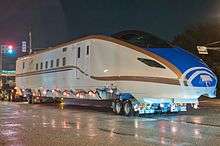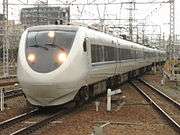W7 Series Shinkansen
| W7 series | |
|---|---|
|
Set W3 on a public preview run, February 2015 | |
| In service | 14 March 2015 |
| Manufacturer | Hitachi, Kawasaki Heavy Industries, Kinki Sharyo |
| Constructed | 2014–2015 |
| Number built | 132 vehicles (11 sets) |
| Number in service | 132 vehicles (11 sets) |
| Formation | 12 cars per set |
| Fleet numbers | W1–W11 |
| Capacity | 934 |
| Operator(s) | JR-West |
| Depot(s) | Hakusan |
| Line(s) served | Hokuriku Shinkansen |
| Specifications | |
| Car body construction | Aluminium alloy |
| Car length |
26,000 mm (85 ft 4 in) (end cars) 25,000 mm (82 ft 0 in) (intermediate cars) |
| Width | 3,380 mm (11 ft 1 in) |
| Doors | 2 sliding doors per side |
| Maximum speed |
Design: 275 km/h (170 mph) Service: 260 km/h (160 mph) |
| Weight | approx. 540 t |
| Power output | 12 MW |
| Acceleration | 1.6 km/h/s |
| Electric system(s) | 25 kV AC, 50/60 Hz |
| Current collection method | Overhead catenary |
| Safety system(s) | DS-ATC, RS-ATC |
| Track gauge | 1,435 mm (4 ft 8 1⁄2 in) |
The W7 series (W7系 Daburu-nana-kei) is a Japanese Shinkansen high-speed train type operated by West Japan Railway Company (JR-West) on the Hokuriku Shinkansen since it was extended from Nagano to Kanazawa in March 2015.[1] Jointly developed alongside the similar JR East E7 series, a total of ten 12-car W7 series sets (120 vehicles) have been built.[2] The first W7 series train was delivered in April 2014.[3]
Design
Based on the earlier E2 series trains, the W7 series trains were designed with a "Japanese" theme inside and out, combining futuristic styling with traditional design elements overseen by industrial designer Ken Okuyama together with Kawasaki Heavy Industries.[4] Externally, the roof is finished in a "sky blue" colour, and the bodysides are "ivory white" with "copper" and "sky blue" lining.[5] The bodyside logos consist of a number "7" in silver stylized as an arrowhead, and include the lettering "West Japan Railway Company".[6]
- Bodyside logo on car 11
Manufacture of the W7 series sets was shared between Hitachi in Kudamatsu, Yamaguchi, Kawasaki Heavy Industries in Kobe, and Kinki Sharyo in Osaka.[7]
The trains have a maximum design speed of 275 km/h (170 mph),[8] but in service operate at a maximum speed of 260 km/h (160 mph) on the Hokuriku Shinkansen, limited to 240 km/h (150 mph) on the Joetsu Shinkansen tracks between Omiya and Takasaki, and to 110 km/h (70 mph) on the Tohoku Shinkansen tracks between Tokyo and Omiya.[1] Increased power output enables the trains to maintain speeds of at least 210 km/h (130 mph) on the steep gradients of the Hokuriku Shinkansen.[2]
Car 12 (Gran Class) is equipped with full active suspension, and the other cars are equipped with semi-active suspension.[8]
Operations
- Kagayaki (Tokyo - Kanazawa), since March 2015
- Hakutaka (Tokyo - Kanazawa), since March 2015
- Tsurugi (Toyama - Kanazawa), since March 2015
- Asama (Tokyo - Nagano), since March 2015
Since 14 March 2015, W7 series trainsets are used on Asama, Hakutaka, Kagayaki, and Tsurugi services alongside JR East E7 series trains.[9]
Formations
The 12-car sets are numbered "W1" onward, and consist of 10 motored ("M") intermediate cars and two non-powered trailer ("T") end cars, as shown below.[10] Car 11 provides Green car (first class) accommodation, and car 12 provides Gran Class luxury accommodation.
| Car No. | 1 | 2 | 3 | 4 | 5 | 6 | 7 | 8 | 9 | 10 | 11 | 12 |
|---|---|---|---|---|---|---|---|---|---|---|---|---|
| Designation | Tc | M2 | M1 | M2 | M1 | M2 | M1 | M2 | M1 | M2 | M1s | Tsc |
| Numbering | W723-100 | W726-100 | W725-100 | W726-200 | W725-200 | W726-300 | W725-300 | W726-400 | W725-400 | W726-500 | W715-500 | W714-500 |
| Weight (t) | 41.3 | 44.7 | 46.1 | 45.2 | 46.4 | 45.2 | 46.5 | 45.2 | 46.4 | 45.0 | 45.6 | 44.5 |
| Capacity | 50 | 100 | 85 | 100 | 85 | 90 | 58 | 100 | 85 | 100 | 63 | 18 |
| Facilities | Toilets | Toilets, phone | Toilets | Wheelchair space, universal access toilet, phone | Toilets | Wheelchair space, universal access toilet | Toilets |
Cars 3 and 7 are each equipped with a single-arm pantograph.[10]
Interior
The 12-car trains have accommodation in three levels of service: Gran Class, Green, and ordinary-class cars, with a total seating capacity of 934.[1] Gran Class seating (car 12) is arranged 2+1 abreast with a seat pitch of 1,300 mm (51 in), Green car seating (car 11) is arranged 2+2 abreast with a seat pitch of 1,160 mm (46 in), and ordinary seating (cars 1 to 10) is arranged 3+2 abreast with a seat pitch of 1,040 mm (41 in).[8] AC power outlets are provided for each seat in all three classes.[8] The Gran class seats are supplied by Toyota Boshoku.[11] Car saloons and vestibule areas are equipped with security cameras.[5] Between October and December 2015, luggage racks are scheduled to be added at one end of each of the even-numbered ordinary class cars and also in Green car 11, by removing a pair of seats (1D and 1E). The luggage racks are to cater to the increased number of overseas tourists with suitcases and also passengers with ski and snowboard equipment in the winter season.[12]
 Interior of a Green car (car 11)
Interior of a Green car (car 11) Green car seating
Green car seating The toilet in Green car 11
The toilet in Green car 11 Interior of an ordinary-class car
Interior of an ordinary-class car Ordinary-class seating (3-abreast row)
Ordinary-class seating (3-abreast row)
History

In January 2012, the head of JR-West's Kanazawa Division revealed that new trains for the Hokuriku Shinkansen would be developed in conjunction with JR East, and that test running would need to be conducted during the winter season a year before the line opening to thoroughly test the ability of the trains to cope with snowy conditions.[13] Details of the new trains were formally announced jointly by JR East and JR-West on 4 September 2012.[5] The design of the logo to be applied to the sides of cars 1 and 12 was officially unveiled in February 2014.[6]
The first W7 series train was delivered from Kawasaki Heavy Industries in Kobe to Hakusan Depot in Hakusan, Ishikawa in April 2014.[3] Test-running on the Hokuriku Shinkansen began on 5 August 2014, initially at low speed, between Kanazawa and Jōetsumyōkō.[14]
In April 2015, JR-West announced that it was ordering an additional E7 series set to be introduced from autumn 2015, replacing the remaining E2 series trainsets used on regularly scheduled Hokuriku Shinkansen Asama services.[15]
In May 2015, the W7 series and JR East E7 series were awarded the 2015 Blue Ribbon Award, presented annually by the Japan Railfan Club.[16] A presentation ceremony was held at JR-West's Hakusan Depot on 24 October 2015.[17]
The W7 series is the first JR-West train type to use the "W" prefix, following the method used by JR East (with an "E" prefix).
Fleet list
As of 1 October 2015, the fleet is as follows.[18]

| Set No. | Manufacturer | Delivery date |
|---|---|---|
| W1 | Kawasaki Heavy Industries | 30 April 2014 |
| W2 | Hitachi | 5 June 2014 |
| W3 | Kawasaki Heavy Industries | 30 June 2014 |
| W4 | Hitachi | 18 July 2014 |
| W5 | Kawasaki Heavy Industries | 21 August 2014 |
| W6 | Kawasaki Heavy Industries | 11 September 2014 |
| W7 | Kinki Sharyo | 27 September 2014 |
| W8 | Hitachi | 15 October 2014 |
| W9 | Hitachi | 3 November 2014 |
| W10 | Kinki Sharyo | 26 December 2014 |
| W11 | Hitachi | 17 September 2015 |
See also
References
- 1 2 3 "E7系・W7系新幹線電車" [E7/W7 series shinkansen EMU]. Japan Railfan Magazine. Vol. 52 no. 619. Japan: Koyusha Co., Ltd. November 2012. pp. 48–49.
- 1 2 Saito, Masatoshi (4 September 2012). JR東:北陸新幹線の新型車両「E7系」概要発表 [JR East announces details of new E7 series for Hokuriku Shinkansen]. Mainichi jp (in Japanese). Japan: The Mainichi Newspapers. Retrieved 4 September 2012.
- 1 2 W7系、30日に石川初走行 白山車両所 [W7 runs for first time inside Hakusan Depot]. The Hokkoku Shimbun (in Japanese). Japan: The Hokkoku Shimbun. 24 April 2014. Retrieved 27 May 2014.
- ↑ 北陸路走る 伝統と未来 新幹線デザイン決定 [Hokuriku Shinkansen design announced - tradition and future]. Chunichi Web (in Japanese). Japan: The Chunichi Shimbun. 5 September 2012. Retrieved 18 September 2012.
- 1 2 3 北陸新幹線用の新型車両について [New trains for Hokuriku Shinkansen] (pdf). Press release (in Japanese). Japan: JR East & JR-West. 4 September 2012. Retrieved 4 September 2012.
- 1 2 北陸新幹線用新型車両シンボルマークデザイン決定 [Logo design finalized for new Hokuriku Shinkansen trains] (PDF). News release (in Japanese). Japan: East Japan Railway Company & West Japan Railway Company. 13 February 2014. Retrieved 13 February 2014.
- ↑ 総合車両製作所、北陸新幹線の車両生産工場増強-60両5編成受注 [J-TREC expands its rolling stock manufacturing facilities for Hokuriku Shinkansen trains, with order for 60 vehicles]. Nikkan Kogyo Shimbun Business Line (in Japanese). Japan: The Nikkan Kogyo Shimbun Ltd. 26 June 2013. Retrieved 3 July 2013.
- 1 2 3 4 "E7系新幹線電車" [E7 series shinkansen EMU]. Japan Railfan Magazine (in Japanese). Vol. 54 no. 634. Japan: Koyusha Co., Ltd. February 2014. pp. 9–13.
- ↑ 北陸新幹線 長野~金沢間開業に伴う運行計画の概要について [Outline of service plans for opening of Hokuriku Shinkansen from Nagano to Kanazawa] (PDF). News release (in Japanese). Japan: JR East & JR-West. 27 August 2014. Retrieved 27 August 2014.
- 1 2 "W7系新幹線電車" [W7 series shinkansen EMU]. Japan Railfan Magazine (in Japanese). Vol. 54 no. 638. Japan: Koyusha Co., Ltd. June 2014. p. 67.
- ↑ トヨタ紡織、鉄道車両用シートを初受注 ~ 北陸新幹線「グランクラス」に採用 ~ [Toyota Boshoku wins first order for train seats - to be used on Hokuriku Shinkansen "Gran Class"]. News Release (in Japanese). Japan: Toyota Boshuku Corporation. 16 April 2013. Retrieved 18 April 2013.
- ↑ 北陸新幹線E7系・W7系への荷物置場の設置について [Installation of luggage racks on Hokuriku Shinkansen E7/W7 series trains]. News release (in Japanese). Japan: West Japan Railway Company. 3 September 2015. Retrieved 3 September 2015.
- ↑ 「大幅変更なし」 七尾線など、新幹線開業後も ["No major changes" to Nanao Line and others even after shinkansen route opens]. Ishikawa News (in Japanese). Japan: The Hokkoku Shimbun. 28 January 2012. Archived from the original on 18 June 2013. Retrieved 4 September 2012.
- ↑ "北陸新幹線金沢~上越妙高間でW7系による走行試験が始まる" [Test-running using W7 series begins on Hokuriku Shinkansen between Kanazawa and Jōetsumyōkō]. Tetsudo Hobidas (in Japanese). Japan: Neko Publishing. 5 August 2014. Retrieved 5 August 2014.
- ↑ JR西 130億円増収効果 16年3月期予想 秋以降に車両追加 [JR-West forecasts profits of 13 billion yen for March 2016 - Additional train from autumn]. Chunichi Web (in Japanese). Japan: The Chunichi Shimbun. 1 May 2015. Retrieved 8 May 2015.
- ↑ ブルーリボン賞・ローレル賞 選定車両一覧 [Blue Ribbon Award & Laurel Prize Winner List] (in Japanese). Japan: Japan Railfan Club. 21 May 2015. Archived from the original on 26 October 2010. Retrieved 21 May 2015.
- ↑ E7系・W7系 ブルーリボン賞を受賞 [E7 and W7 series receive Blue Ribbon Award]. Japan Railfan Magazine (in Japanese). Vol. 56 no. 658. Japan: Koyusha Co., Ltd. February 2016. p. 67.
- ↑ JR電車編成表 2016冬 [JR EMU Formations - Winter 2016] (in Japanese). Japan: Kotsu Shimbunsha. 18 November 2015. p. 134. ISBN 978-4-330-62315-3.
External links
| Wikimedia Commons has media related to W7 series. |
- Official website (Japanese)





